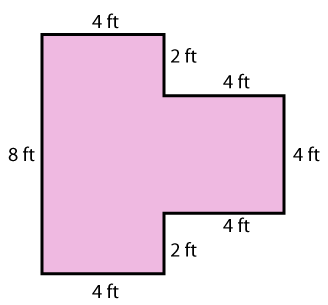Unknown figures do not fit into a single geometric definition. However, they can be viewed as a combination of several different known figures. When you encounter an unknown figure, instead of thinking of the figure as a single, unified object, try to figure out the known objects that make up the odd shape. Consider the shape below.

This shape doesn't seem to conform to any of the standard, or "known," definitions of geometric figures. However, you can pretty easily tell that it can be divided into two rectangles. Once you know which shapes compose the unknown shape, you can easily calculate the area. Study the slides below to learn how.
|
Step 1: Divide the unknown figure into known figures.
You can see that the shape seems to be made up of two rectangles. Although there is no dividing line, you can create an imaginary one in order to better see the division. The imaginary line is represented as a dashed line above. Step 2: Calculate the individual areas of the known figures.
In order to learn the area of the entire image, you first have to calculate the area of each individual rectangle. As you can see, one rectangle is 8 feet by 4 feet and the other is 4 feet by 4 feet (so the second one is actually a square). Using the formula for calculating the area of a rectangle, try finding the area of the two known shapes in this figure. Then, click the button below to check your answer.
The area of the first rectangle is 8 feet multiplied by 4 feet, or 32 square feet. The area of the second rectangle is 4 feet multiplied by 4 feet, or 16 square feet.
Step 3: Sum the areas of the known figures.
You now know the area of each individual rectangle, which means you know the area of every known figure contained within the unknown figure. Because the unknown shape is the combination of the two rectangles, you can find the area of the shape by adding together the areas of the individual rectangles. Try finding the area of the unknown figure. Then, click the button below to check your answer.
The area of the entire shape is the sum of the areas of the two individual rectangles. The total area is 32 square feet plus 16 square feet, or 48 square feet.
|
Use the activity below to practice the first step in the process above.Try identifying the known figures that make up the unknown figures below.

What known figures make up this unknown figure?

This figure is made up of a rectangle and two half circles.

What known figures make up this unknown figure?

This figure is made up of two half circles, two triangles, and two rectangles.

What known figures make up this unknown figure?

This figure is made up of three rectangles, a triangle, and a quarter circle. However, note that an area in the shape of a half circle has been removed from the lower left hand rectangle.
Cards remaining:

